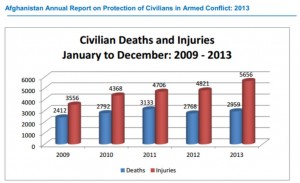Civilian Casualties Rise Yet Again in Afghanistan, Confirming Surge Failure
The United Nations is the best source of information on the impact of the war in Afghanistan on civilians. They released their latest data this weekend (pdf), and their results show that the vaunted “surge” of US troops into the country in early 2010 through late 2012 failed to protect civilians. In fact, the data show that civilian injuries have shown a steady rise from 2009 pre-surge levels through 2013’s post-surge period. Civilian deaths rose in 2010 and 2011. They went down slightly in 2012 before rising again in 2013.
Despite this clear indication that the surge was a waste of lives and money, recall that the Pentagon continued to spew its positive spin as troops were drawn down. From September, 2012 as the surge ended:
Very quietly, the surge of troops into Afghanistan that President Obama announced to such fanfare in late 2009 is now over.
Defense Secretary Leon Panetta said today that 33,000 troops have been withdrawn, calling the Afghan surge “a very important milestone” in a war the Obama administration is winding down; there are sill 68,000 U.S. troops in Afghanistan.
The “surge did accomplish its objectives of reversing the Taliban momentum on the battlefield and dramatically increase the size and capability of the Afghan national security forces,” Panetta said.
As seen in the UN data, the surge did nothing to reverse attacks on civilians, with civilian casualties continuing a steady increase. How about Panetta’s other claim, the one about dramatically increasing the size and capability of Afghan national security forces? To answer that, we depend on data supplied by the Special Inspector General for Afghanistan Reconstruction. Their latest report can be found here (pdf). Once again, the target for ANSF size was not achieved, even after moving the goalposts (footnotes removed):
This quarter, ANSF’s assigned force strength was 334,852, according to data provided by CSTC-A. This is short of the goal to have an end strength of 352,000 ANSF personnel by October 2012. That goal had been in the Department of Defense’s (DOD) April 2012 Report on Progress Toward Security and Stability in Afghanistan. When that end strength was not met, DOD revised the goal to 352,000 ANSF by 2014 (187,000 ANA by December 2012, 157,000 ANP by February 2013, and 8,000 Air Force by December 2014). Neither the ANA nor the ANP met their end-strength goal by the revised deadline, as shown in Table 3.6.
But the reality could be far worse than those numbers indicate. While the force size falls just barely short of the target, the functionality of those troops is suspect. Further, it appears that Afghanistan may be playing games with the meaning of “available” (sorry, this bit of text won’t copy, so I have to use images instead): Read more →

